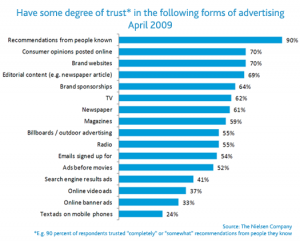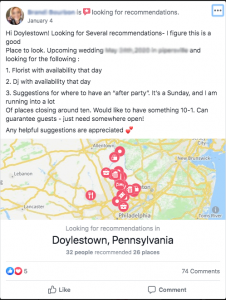Meet Lisa and Steven.

Lisa and Steven are getting married next week (congrats, kids!). Anyone who knows anything about weddings will tell you, it’s been a long, long process to plan the big event. (And anyone who doesn’t, should talk to the couple’s parents. They are very ready for the wedding to be over).
And through this long process Lisa and Steven have talked to a lot of people in the wedding industry – wedding venues, officiants, bakers, florists, photographers, hairdressers, DJs, wedding planners, limo rental companies, make up artists, dressmakers, seamstresses, tuxedo shops, and a whole lot of other vendors (want to elope yet?).
While Lisa and Steven might only connect and work with any and all of these professionals for a few months, weeks, or just the day of the wedding, to these vendors Lisa and Steven are valuable customers not just for that period of time.
The thing is, Lisa has three engaged bridesmaids and 15 college friends some of whom have babies. Steven’s brother is getting married next year. Lisa’s mom’s cousin’s niece is going to the prom in the spring. And Steven’s dad is about to retire.
All these people will be looking for photographers, hairdressers, make up artists, tuxedo shops, limo drivers, and cake bakeries. And not just for weddings, but for baby showers, retirement parties, family reunions, birthday parties, and the list goes on. While some of them will look up businesses online, many will turn to their friends and family for recommendations.
That is why customer referrals are the biggest thing in the wedding industry since sliced cake.
What numbers say about customer referrals
Outside of the world of white lace and perfect roses, the picture is not much different. According to Nielsen research, 90% of consumers surveyed noted that they trust recommendations from people they know, while 70 percent trusted consumer opinions posted online. This is true in both, B2C and B2B marketing.

Other experts agree that customer referrals are worth their weight in gold.
Fred Reichheld, the creator of the Net Promoter Score and recognized leader in customer satisfaction and loyalty, once wrote
“…the value of any one customer does not reside only in what that person buys. In these interconnected days, how your customers feel about you and what they are prepared to tell others about you can influence your revenues and profits just as much.” (Harvard Business Review)
That influence can have both positive and negative effects.
According to one study, 13% of customers will share their negative experience with a company with 15 or even more people. On the other hand, 72% of customers will share a positive experience with 6 or more people. (Kolsky)
Customer referrals not only bring in leads but also determine the way those leads’ future behaviors.
A 2018 study by Heinz Marketing found that:
- 60 % of companies with a referral process experience faster close rates.
- 59 % report higher customer lifetime value.
- 71% report higher conversion from contact to customer.
Additionally, a study found that it takes a referred customer 18% more time to leave a business than it does for an average customer. (Wharton School, University of Pennsylvania)
Customer referrals beyond the numbers
Reichheld’s statement stresses that customer value includes the ability to bring in new, profitable customers. The statistics above prove that referrals help businesses get leads, gain clients, and retain loyal customers.
Real-life examples also show the benefits of referrals.
Lisa and Steven’s recommendations to their friends and family will do wonders for the vendors they mention. These referrals might go beyond in-person word of mouth and make their way on social media. The happy couple’s online friends and connections might also be among those looking for products and services.

Let’s not forget about the power of another type of referral – online reviews. On average, 92% of consumers regularly read online reviews before committing, and 84% trust those reviews as much as they would a personal recommendation from a friend.

All these customer referrals and reviews that bring new business opportunities come at a lower cost, faster speed, and have a bigger return of investment. (Bill Cates, HubSpot)
Moreover, clients that come to a business through customer referrals often already have an established personal relationship with the company. For example, Lisa’s engaged bridesmaids already worked with the makeup artist or photographer Lisa recommended.
As evident from this review, a pre-existing personal relationship sets a positive tone to the experience ahead of time.

How can a company increase customer referrals
Now that the importance of referrals is clear, what can companies do to increase the frequency and the quality of the referrals they get?
Reichheld’s statement looks at customer satisfaction and loyalty as equal metrics, demanding proactive plans to maximize the opportunity. It’s important to recognize a company’s opportunity to move satisfied customers into advocates of a brand’s product or service.
Companies with high performing referral metrics all have one thing in common. They have a process for seeking out customer referrals and introductions.

For these organizations, it’s not about “fill out the survey at the bottom and you’ll win a free dessert”. It’s about ensuring there are a culture and a process to ensure the correct attitudes, behaviors, and techniques are in place to drive customer satisfaction, loyalty, and referrals.
Here’s a three-ingredient customer referrals process that leads to successful profit growth.
Attitudes
The attitude part of the customer referral is the “Why?” of the process. Why would a customer recommend the business to someone else? The answer should be “because of how good the product and the service are.”

A customer-centered culture plays an important role in the overall customer experience. As evident from the above statistics, an excellent customer experience is more likely to lead to more customer referrals.
There are plenty of examples of how failure to listen to customers and adapt to change can cause a company’s eventual downfall.
Organizations must look at the overall employee attitudes.
What are corporate attitudes about customer satisfaction? From CEO to the front line employees. If the culture is one of “minimize the bad,” or “collect surveys” it will drive much different results than one that looks at each customer as a multiple for existing opportunity.
Therefore, the drive to provide excellent customer experience for each customer is an essential tool in getting customer referrals. If the customers feel special they will make sure to tell their friends.
Behaviors
If the employee attitudes make the “Why?” of the referral, the behavior part is the “How?” How would an employee ask for a referral and how would a customer provide it?
Do front line employees simply “ask for a referral” at the end of a sale as a matter of process (fill out the survey, get a free dessert)? Or do they ask at other, critical points of the customer journey, as if they are bought in, not only checking a box?
This is an important point about customer journey, a term used to describe all of a client’s interactions with a company, beginning to end. During this journey the customer and the business both experience multiple touchpoints.
As an example, a hotel may place a feedback kiosk at the front desk. That will allow guests to provide feedback at both the check in and the checkout. The management might choose to ask the guest to provide referral information at one point or the other or both, depending on what works best for that specific business.

Asking for referrals at that specific time and in a specific manner can make a difference between getting a referral or having the customer ride into the sunset never to be seen or heard from again.
Techniques
The “What?” of the customer referrals process, the techniques of asking for referrals work together with the attitudes and the behaviors. What is the referral program that works for a specific company in a specific industry?
Unfortunately, this is where the bulk of organizations that have referral programs spend their time. The debates on this topic usually sound like the following: “Should we offer a free dessert or a gift card?” “Should everyone that refers a customer earn a reward?” “What if we give a reward to both the current customer and the person they are referring to?
While the techniques of customer referrals programs are an important part of the process, it only works effectively in conjunction with the other two essential ingredients in the process, attitude, and behavior.
All of these questions and debates usually lead to the final two questions:
- What works in our industry?
These questions come up last because organizations focus on the “What” (techniques) instead of the “Why” (Attitudes) and How (Behaviors).
Without a process and systems in place to proactively gain referrals, it’s difficult to measure the effectiveness of any program, or the employees responsible for growing the business. As a result, coaching employees on referrals, and adapting the program to target your most valuable referrals.”
The specific technique for customer referrals, therefore, should arise only as an end process of the whole process of the program. What works for one company may not work for another.
What works for the goose may not work for the gander.
Bottom Line
When companies are able to accurately target customers who are likely to make profitable referrals, they will earn a better return on their marketing investment. When systematized and with the right attitudes, behaviors, and techniques in place, referrals are one of the most powerful forms of marketing and among the least expensive.

